Energy Storage Science and Technology ›› 2023, Vol. 12 ›› Issue (7): 2059-2078.doi: 10.19799/j.cnki.2095-4239.2023.0462
Previous Articles Next Articles
Lingxuan LI1,2,3( ), Zixuan WANG1,2,3, Chenzi ZHAO3(
), Zixuan WANG1,2,3, Chenzi ZHAO3( ), Rui ZHANG4, Yang LU3, Jiaqi HUANG1,2, Aibing CHEN5, Qiang ZHANG3
), Rui ZHANG4, Yang LU3, Jiaqi HUANG1,2, Aibing CHEN5, Qiang ZHANG3
Received:2023-07-03
Revised:2023-07-08
Online:2023-07-05
Published:2023-07-25
Contact:
Chenzi ZHAO
E-mail:lingxuan2000@bit.edu.cn;zcz@mail.tsinghua.edu.cn
CLC Number:
Lingxuan LI, Zixuan WANG, Chenzi ZHAO, Rui ZHANG, Yang LU, Jiaqi HUANG, Aibing CHEN, Qiang ZHANG. A review of numerical models for composite lithium metal anodes[J]. Energy Storage Science and Technology, 2023, 12(7): 2059-2078.
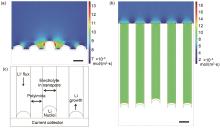
Fig. 3
Simulation of lithium ion flux distribution in electrodes and schematic diagram of the simulation structure[91] (a) Simulation of lithium ion flux distribution in planar electrodes; (b) Simulation of lithium ion flux distribution in nanochannel electrodes of 3.5 μm; (c) Simulation cell geometry for the case with nanochannel electrodes. Scale bars: 400 nm"

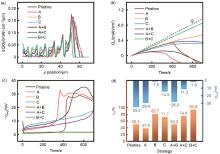
Fig. 6
(a) Depth distribution of lithium metal deposition; (b) Time evolution curve of deposition capacity in pores; (c) Activation overpotential required for constant current lithium deposition; (d) Proportion of lithium metal in pores and average activation overpotential under different strategies at 600 s[74]"


Fig. 7
Phase field simulations of the galvanostatic lithium plating and stripping processes[63](a)—(c) Lithium dendrite growth at 0, 240.0, and 480.0 s, respectively, with a platingcurrent density of 10 mA/cm2; (d)—(f) Dead lithium formation process at 0, 240.0, and 404.8 s, with a stripping current density of 10 mA/cm2"
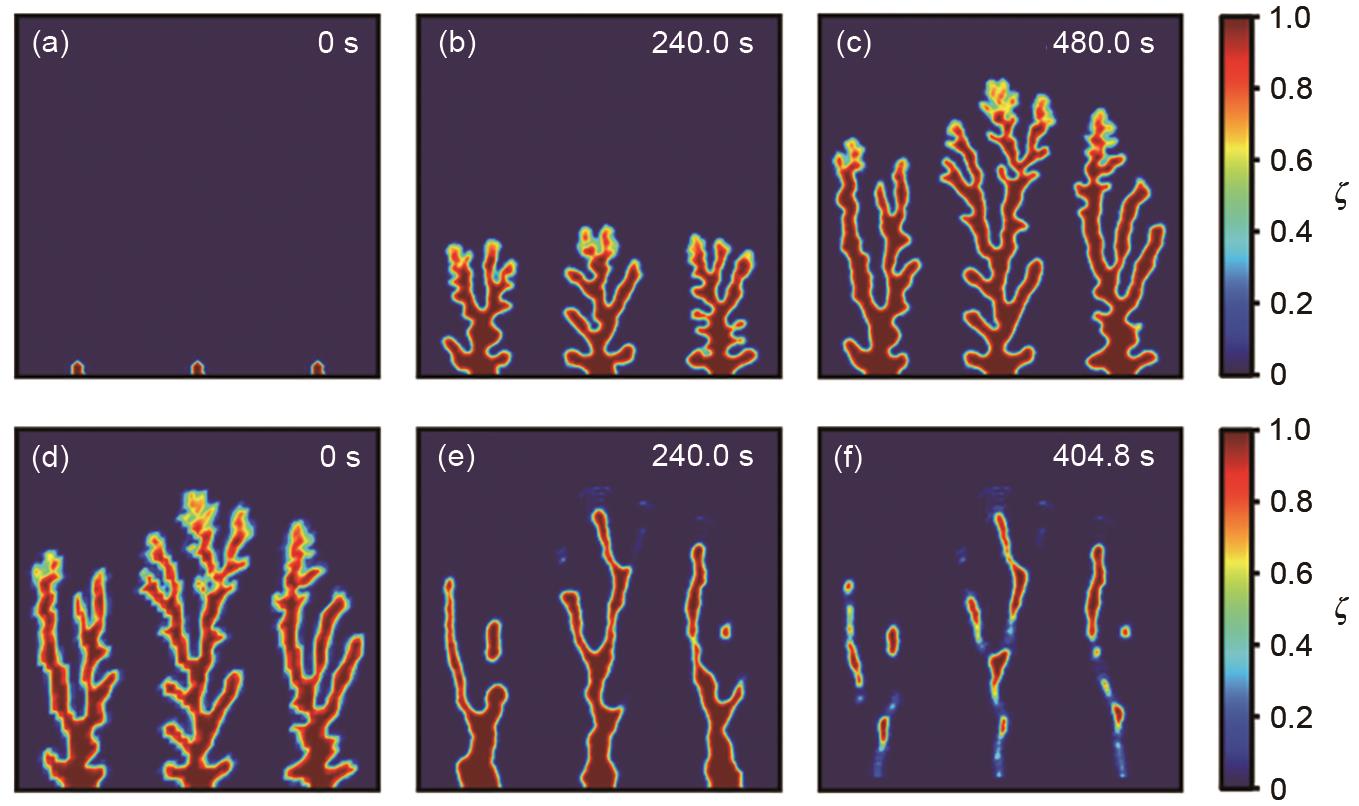
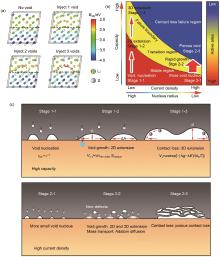
Fig. 8
The interfacial evolution principle during Li stripping and the actual condition of morphology evolution[125] (a) the site energy evolution after void injection by DFT calculations; (b) The void evolution regulated by the current-stripping areal capacity and current density; (c) The schematic of micro-scopic evolution in different void accumulation circumstances"


Fig. 9
The pressure shaping effect on the Li dendrite growth in electrolytes of elastic moduli ranging from 0.5 to 2.0 GPa. The applied external pressure is fixed at 6.0 MPa [130] (a) the snapshots of dendritic morphology at a plating capacity of 0.40 mAh/cm2; (b) The current density evolution with the proceeding of electroplating; (c) The space utilization in different electrolytes; (d) The phase diagram based on the applied external pressure and the elastic modulus of electrolyte at a plating capacity of 0.4 mAh/cm2. The gray portion denotes that the external pressure fails to work"
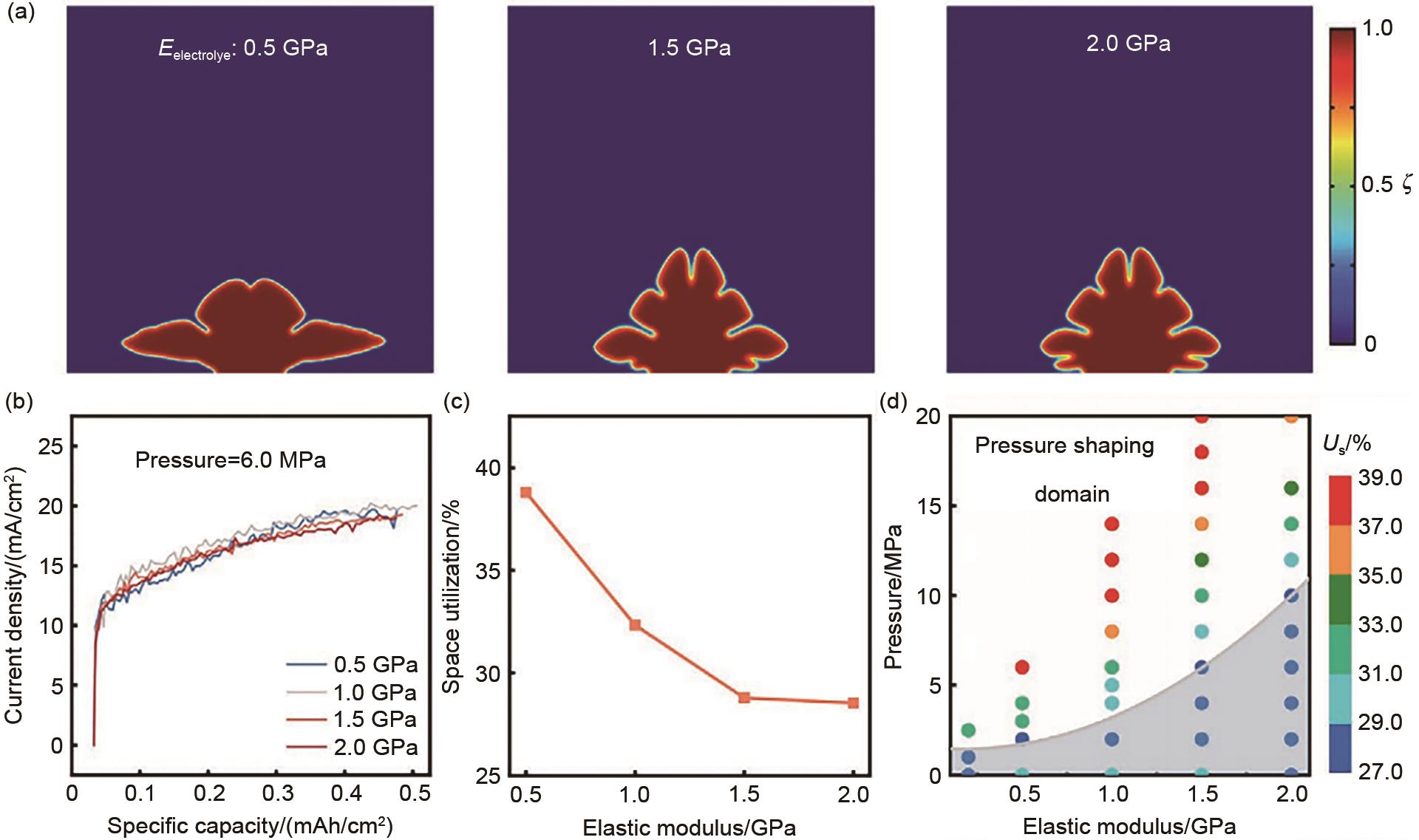
| 1 | ZHANG X Q, ZHAO C Z, HUANG J Q, et al. Recent advances in energy chemical engineering of next-generation lithium batteries[J]. Engineering, 2018, 4(6): 831-847. |
| 2 | TIAN Y, LIN C, CHEN X, et al. Reversible lithium plating on working anodes enhances fast charging capability in low-temperature lithium-ion batteries[J]. Energy Storage Materials, 2023, 56: 412-423. |
| 3 | LIU H, CHENG X B, CHONG Y, et al. Advanced electrode processing of lithium ion batteries: A review of powder technology in battery fabrication[J]. Particuology, 2021, 57: 56-71. |
| 4 | ZHANG R, CHEN X, SHEN X, et al. Coralloid carbon fiber-based composite lithium anode for robust lithium metal batteries[J]. Joule, 2018, 2(4): 764-777. |
| 5 | LIU D H, BAI Z Y, LI M, et al. Developing high safety Li-metal anodes for future high-energy Li-metal batteries: Strategies and perspectives[J]. Chemical Society Reviews, 2020, 49(15): 5407-5445. |
| 6 | LIU B, ZHANG J G, XU W. Advancing lithium metal batteries[J]. Joule, 2018, 2(5): 833-845. |
| 7 | STARK J K, DING Y, KOHL P A. Nucleation of electrodeposited lithium metal: Dendritic growth and the effect of co-deposited sodium[J]. Journal of the Electrochemical Society, 2013, 160(9): D337-D342. |
| 8 | XU W, WANG J L, DING F, et al. Lithium metal anodes for rechargeable batteries[J]. Energy & Environmental Science, 2014, 7(2): 513-537. |
| 9 | ZHANG H M, LIAO X B, GUAN Y P, et al. Lithiophilic-lithiophobic gradient interfacial layer for a highly stable lithium metal anode[J]. Nature Communications, 2018, 9: 3729. |
| 10 | HAN Y Y, LIU B, XIAO Z, et al. Interface issues of lithium metal anode forhigh-energy batteries: Challenges, strategies, and perspectives[J]. InfoMat, 2021, 3(2): 155-174. |
| 11 | GAO M D, LI H, XU L, et al. Lithium metal batteries for high energy density: Fundamental electrochemistry and challenges[J]. Journal of Energy Chemistry, 2021, 59: 666-687. |
| 12 | ZHU G L, ZHAO C Z, YUAN H, et al. Liquid phase therapy with localized high-concentration electrolytes for solid-state Li metal pouch cells[J]. Acta Physico Chimica Sinica, 2020: 2005003. |
| 13 | LI M, WANG C S, CHEN Z W, et al. New concepts in electrolytes[J]. Chemical Reviews, 2020, 120(14): 6783-6819. |
| 14 | ZHANG X Q, CHEN X, CHENG X B, et al. Highly stable lithium metal batteries enabled by regulating the solvation of lithium ions in nonaqueous electrolytes[J]. Angewandte Chemie (International Ed in English), 2018, 57(19): 5301-5305. |
| 15 | ZHANG W D, WU Q A, HUANG J X, et al. Colossal granular lithium deposits enabled by the grain-coarsening effect for high-efficiency lithium metal full batteries[J]. Advanced Materials, 2020, 32(24): 2001740. |
| 16 | ZHAO Q, STALIN S, ZHAO C Z, et al. Designing solid-state electrolytes for safe, energy-dense batteries[J]. Nature Reviews Materials, 2020, 5(3): 229-252. |
| 17 | FAN X L, CHEN L, BORODIN O, et al. Non-flammable electrolyte enables Li-metal batteries with aggressive cathode chemistries[J]. Nature Nanotechnology, 2018, 13(8): 715-722. |
| 18 | SHI P, LIU Z Y, ZHANG X Q, et al. Polar interaction of polymer host-solvent enables stable solid electrolyte interphase in composite lithium metal anodes[J]. Journal of Energy Chemistry, 2022, 64: 172-178. |
| 19 | XU R, CHENG X B, YAN C, et al. Artificial interphases for highly stable lithium metal anode[J]. Matter, 2019, 1(2): 317-344. |
| 20 | XIAO Y, XU R, YAN C, et al. Waterproof lithium metal anode enabled by cross-linking encapsulation[J]. Science Bulletin, 2020, 65(11): 909-916. |
| 21 | LIU S F, JI X A, YUE J E, et al. High interfacial-energy interphase promoting safe lithium metal batteries[J]. Journal of the American Chemical Society, 2020, 142(5): 2438-2447. |
| 22 | LI N W, SHI Y, YIN Y X, et al. A flexible solid electrolyte interphase layer for long-life lithium metal anodes[J]. Angewandte Chemie International Edition, 2018, 57(6): 1505-1509. |
| 23 | LI T, SHI P, ZHANG R, et al. Dendrite-free sandwiched ultrathin lithium metal anode with even lithium plating and stripping behavior[J]. Nano Research, 2019, 12(9): 2224-2229. |
| 24 | HE X, YANG Y, CRISTIAN M S, et al. Uniform lithium electrodeposition for stable lithium-metal batteries[J]. Nano Energy, 2020, 67: 104172. |
| 25 | MENG N, ZHU X G, LIAN F. Particles in composite polymer electrolyte for solid-state lithium batteries: A review[J]. Particuology, 2022, 60: 14-36. |
| 26 | WANG C W, GONG Y H, LIU B Y, et al. Conformal, nanoscale ZnO surface modification of garnet-based solid-state electrolyte for lithium metal anodes[J]. Nano Letters, 2017, 17(1): 565-571. |
| 27 | ZHANG Y, LUO W, WANG C W, et al. High-capacity, low-tortuosity, and channel-guided lithium metal anode[J]. Proceedings of the National Academy of Sciences of the United States of America, 2017, 114(14): 3584-3589. |
| 28 | WANG H S, LIN D C, LIU Y Y, et al. Ultrahigh-current density anodes with interconnected Li metal reservoir through overlithiation of mesoporous AlF3 framework[J]. Science Advances, 2017, 3(9): e1701301. |
| 29 | LIU Y Y, LIN D C, LIANG Z, et al. Lithium-coated polymeric matrix as a minimum volume-change and dendrite-free lithium metal anode[J]. Nature Communications, 2016, 7: 10992. |
| 30 | LIN D C, LIU Y Y, LIANG Z, et al. Layered reduced graphene oxide with nanoscale interlayer gaps as a stable host for lithium metal anodes[J]. Nature Nanotechnology, 2016, 11(7): 626-632. |
| 31 | LIANG Z, LIN D C, ZHAO J, et al. Composite lithium metal anode by melt infusion of lithium into a 3D conducting scaffold with lithiophilic coating[J]. Proceedings of the National Academy of Sciences of the United States of America, 2016, 113(11): 2862-2867. |
| 32 | SHEN X, CHENG X B, SHI P, et al. Lithium-matrix composite anode protected by a solid electrolyte layer for stable lithium metal batteries[J]. Journal of Energy Chemistry, 2019, 37: 29-34. |
| 33 | SHI P, LI T, ZHANG R, et al. Lithiophilic LiC6 layers on carbon hosts enabling stable Li metal anode in working batteries[J]. Advanced Materials, 2019, 31(8): e1807131. |
| 34 | LI Q, ZHU S P, LU Y Y. 3D porous Cu current collector/Li-metal composite anode for stable lithium-metal batteries[J]. Advanced Functional Materials, 2017, 27(18): 1606422. |
| 35 | YE H A, ZHENG Z J, YAO H R, et al. Guiding uniform Li plating/stripping through lithium-aluminum alloying medium for long-life Li metal batteries[J]. Angewandte Chemie International Edition, 2019, 58(4): 1094-1099. |
| 36 | YANG C P, XIE H A, PING W W, et al. An electron/ion dual-conductive alloy framework for high-rate and high-capacity solid-state lithium-metal batteries[J]. Advanced Materials, 2019, 31(3): 1804815. |
| 37 | LIANG X, PANG Q, KOCHETKOV I R, et al. A facile surface chemistry route to a stabilized lithium metal anode[J]. Nature Energy, 2017, 2: 17119. |
| 38 | CHANG J, SHANG J, SUN Y M, et al. Flexible and stable high-energy lithium-sulfur full batteries with only 100% oversized lithium[J]. Nature Communications, 2018, 9: 4480. |
| 39 | LIU K, KONG B, LIU W, et al. Stretchable lithium metal anode with improved mechanical and electrochemical cycling stability[J]. Joule, 2018, 2(9): 1857-1865. |
| 40 | LI T, LIU H, SHI P, et al. Recent progress in carbon/lithium metal composite anode for safe lithium metal batteries[J]. Rare Metals, 2018, 37(6): 449-458. |
| 41 | YANG C P, YIN Y X, ZHANG S F, et al. Accommodating lithium into 3D current collectors with a submicron skeleton towards long-life lithium metal anodes[J]. Nature Communications, 2015, 6: 8058. |
| 42 | YUE X Y, WANG W W, WANG Q C, et al. CoO nanofiber decorated nickel foams as lithium dendrite suppressing host skeletons for high energy lithium metal batteries[J]. Energy Storage Materials, 2018, 14: 335-344. |
| 43 | WAN M T, KANG S J, WANG L, et al. Mechanical rolling formation of interpenetrated lithium metal/lithium tin alloy foil for ultrahigh-rate battery anode[J]. Nature Communications, 2020, 11: 829. |
| 44 | PAN L H, LUO Z F, ZHANG Y T, et al. Seed-free selective deposition of lithium metal into tough graphene framework for stable lithium metal anode[J]. ACS Applied Materials & Interfaces, 2019, 11(47): 44383-44389. |
| 45 | LIANG Z, ZHENG G, LIU C, et al. Polymer nanofiber-guided uniform lithium deposition for battery electrodes [J]. Nano Letters, 2015, 15(5): 2910-2916. |
| 46 | CHAZALVIEL J. Electrochemical aspects of the generation of ramified metallic electrodeposits[J]. Physical Review A, Atomic, Molecular, and Optical Physics, 1990, 42(12): 7355-7367. |
| 47 | 沈馨, 张睿, 程新兵, 等. 锂枝晶的原位观测及生长机制研究进展[J]. 储能科学与技术, 2017, 6(3): 418-432. |
| SHEN X, ZHANG R, CHENG X B, et al. Recent progress on in situ observation and growth mechanism of lithium metal dendrites[J]. Energy Storage Science and Technology, 2017, 6(3): 418-432. | |
| 48 | CHENG X B, HOU T Z, ZHANG R, et al. Dendrite-free lithium deposition induced by uniformly distributed lithium ions for efficient lithium metal batteries[J]. Advanced Materials, 2016, 28(15): 2888-2895. |
| 49 | LIU J, YUAN H, CHENG X B, et al. A review of naturally derived nanostructured materials for safe lithium metal batteries[J]. Materials Today Nano, 2019, 8: 100049. |
| 50 | LIU J A, YUAN H, LIU H, et al. Unlocking the failure mechanism of solid state lithium metal batteries[J]. Advanced Energy Materials, 2022, 12(4): 2100748. |
| 51 | LIU Q, YU J H, GUO W Q, et al. Boosting the Li|LAGP interfacial compatibility with trace nonflammable all-fluorinated electrolyte: The role of solid electrolyte interphase[J]. EcoMat, 2023, 5(4): 12322. |
| 52 | LIU H, CHENG X B, YAN C, et al. A perspective on energy chemistry of low-temperature lithium metal batteries[J]. iEnergy, 2022, 1(1): 72-81. |
| 53 | ZHANG J, QIAO J S, SUN K N, et al. Balancing particle properties for practical lithium-ion batteries[J]. Particuology, 2022, 61: 18-29. |
| 54 | ZHANG L S, CHEN S Y, WANG W T, et al. Enabling dendrite-free charging for lithium batteries based on transport-reaction competition mechanism in CHAIN framework[J]. Journal of Energy Chemistry, 2022, 75: 408-421. |
| 55 | MA Q T, SUN X W, LIU P, et al. Bio-inspired stable lithium-metal anodes by co-depositing lithium with a 2D vermiculite shuttle[J]. Angewandte Chemie (International Ed in English), 2019, 58(19): 6200-6206. |
| 56 | WANG S H, YIN Y X, ZUO T T, et al. Stable Li metal anodes via regulating lithium plating/stripping in vertically aligned microchannels[J]. Advanced Materials, 2017, 29(40): 1703729. |
| 57 | ZHANG L H, YIN X G, SHEN S B, et al. Simultaneously homogenized electric field and ionic flux for reversible ultrahigh-areal-capacity Li deposition[J]. Nano Letters, 2020, 20(8): 5662-5669. |
| 58 | ZHANG R, SHEN X, CHENG X B, et al. The dendrite growth in 3D structured lithium metal anodes: Electron or ion transfer limitation?[J]. Energy Storage Materials, 2019, 23: 556-565. |
| 59 | SMITH R B, BAZANT M Z. Multiphase porous electrode theory[J]. Journal of the Electrochemical Society, 2017, 164(11): E3291-E3310. |
| 60 | FOROOZAN T, SOTO F A, YURKIV V, et al. Synergistic effect of graphene oxide for impeding the dendritic plating of Li[J]. Advanced Functional Materials, 2018, 28(15): 1705917. |
| 61 | TIAN H K, LIU Z, JI Y Z, et al. Interfacial electronic properties dictate Li dendrite growth in solid electrolytes[J]. Chemistry of Materials, 2019, 31(18): 7351-7359. |
| 62 | CHEN L, ZHANG H W, LIANG L Y, et al. Modulation of dendritic patterns during electrodeposition: A nonlinear phase-field model[J]. Journal of Power Sources, 2015, 300: 376-385. |
| 63 | ZHANG R, SHEN X, ZHANG Y T, et al. Dead lithium formation in lithium metal batteries: A phase field model[J]. Journal of Energy Chemistry, 2022, 71: 29-35. |
| 64 | CHEN H Y, LI M X, LI C P, et al. Electrospun carbon nanofibers for lithium metal anodes: Progress and perspectives[J]. Chinese Chemical Letters, 2022, 33(1): 141-152. |
| 65 | LIU Y Y, ZHU Y Y, CUI Y. Challenges and opportunities towards fast-charging battery materials[J]. Nature Energy, 2019, 4(7): 540-550. |
| 66 | 王达, 周航, 焦遥, 等. 离子嵌入电化学反应机理的理解及性能预测:从晶体场理论到配位场理论[J]. 储能科学与技术, 2022, 11(2): 409-433. |
| WANG D, ZHOU H, JIAO Y, et al. Understanding and performance prediction of ions-intercalation electrochemistry: From crystal field theory to ligand field theory[J]. Energy Storage Science and Technology, 2022, 11(2): 409-433. | |
| 67 | CHENG X B, YAN C, ZHANG X Q, et al. Electronic and ionic channels in working interfaces of lithium metal anodes[J]. ACS Energy Letters, 2018, 3(7): 1564-1570. |
| 68 | YANG S J, XU X Q, CHENG X B, et al. Columnar lithium metal deposits: The role of non-aqueous electrolyte additive[J]. Acta Physico Chimica Sinica, 2020: 2007058. |
| 69 | ZHAO C Z, DUAN H, HUANG J Q, et al. Designing solid-state interfaces on lithium-metal anodes: A review[J]. Science China Chemistry, 2019, 62(10): 1286-1299. |
| 70 | ZHANG R, LI N W, CHENG X B, et al. Advanced micro/nanostructures for lithium metal anodes[J]. Advanced Science, 2017, 4(3): 1600445. |
| 71 | FU Z H, CHEN X A, ZHAO C Z, et al. Stress regulation on atomic bonding and ionic diffusivity: Mechanochemical effects in sulfide solid electrolytes[J]. Energy & Fuels, 2021, 35(12): 10210-10218. |
| 72 | SCHARIFKER B, HILLS G. Theoretical and experimental studies of multiple nucleation[J]. Electrochimica Acta, 1983, 28(7): 879-889. |
| 73 | MONROE C, NEWMAN J. Dendrite growth in lithium/polymer systems[J]. Journal of the Electrochemical Society, 2003, 150(10): A1377. |
| 74 | MONROE C, NEWMAN J. The impact of elastic deformation on deposition kinetics at lithium/polymer interfaces[J]. Journal of the Electrochemical Society, 2005, 152(2): A396. |
| 75 | MONROE C, NEWMAN J. The effect of interfacial deformation on electrodeposition kinetics[J]. Journal of the Electrochemical Society, 2004, 151(6): A880. |
| 76 | GOLMON S, MAUTE K, DUNN M L. Numerical modeling of electrochemical-mechanical interactions in lithium polymer batteries[J]. Computers & Structures, 2009, 87(23/24): 1567-1579. |
| 77 | JANA A, WOO S I, VIKRANT K S N, et al. Electrochemomechanics of lithium dendrite growth [J]. Energy & Environmental Science, 2019, 12(12): 3595-3607. |
| 78 | ZHANG R, SHEN X, JU H T, et al. Driving lithium to deposit inside structured lithium metal anodes: A phase field model[J]. Journal of Energy Chemistry, 2022, 73: 285-291. |
| 79 | ARYANFAR A, BROOKS D, MERINOV B V, et al. Dynamics of lithium dendrite growth and inhibition: Pulse charging experiments and Monte Carlo calculations[J]. The Journal of Physical Chemistry Letters, 2014, 5(10): 1721-1726. |
| 80 | AKOLKAR R. Mathematical model of the dendritic growth during lithium electrodeposition[J]. Journal of Power Sources, 2013, 232: 23-28. |
| 81 | AKOLKAR R. Modeling dendrite growth during lithium electrodeposition at sub-ambient temperature[J]. Journal of Power Sources, 2014, 246: 84-89. |
| 82 | XU X Q, CHENG X B, JIANG F N, et al. Dendrite-accelerated thermal runaway mechanisms of lithium metal pouch batteries[J]. SusMat, 2022, 2(4): 435-444. |
| 83 | PARK J, JEONG J, LEE Y J, et al. Micro-patterned lithium metal anodes with suppressed dendrite formation for post lithium-ion batteries[J]. Advanced Materials Interfaces, 2016, 3(11): 1600140. |
| 84 | XU B Q, LIU Z, LI J X, et al. Engineering interfacial adhesion for high-performance lithium metal anode[J]. Nano Energy, 2020, 67: 104242. |
| 85 | LI G X, LIU Z, WANG D W, et al. Electrokinetic phenomena enhanced lithium-ion transport in leaky film for stable lithium metal anodes[J]. Advanced Energy Materials, 2019, 9(22): 1900704. |
| 86 | NADKARNI N, ZHOU T T, FRAGGEDAKIS D, et al. Modeling the metal-insulator phase transition in LixCoO2 for energy and information storage[J]. Advanced Functional Materials, 2019, 29(40): 1902821. |
| 87 | GUYER J E, BOETTINGER W J, WARREN J A, et al. Phase field modeling of electrochemistry. I. Equilibrium[J]. Physical Review E, 2004, 69(2): 021603. |
| 88 | GUYER J E, BOETTINGER W J, WARREN J A, et al. Phase field modeling of electrochemistry. Ⅱ. Kinetics[J]. Physical Review E, 2004, 69(2): 021604. |
| 89 | SHIBUTA Y, OKAJIMA Y, SUZUKI T. Phase-field modeling for electrodeposition process[J]. Science and Technology of Advanced Materials, 2007, 8(6): 511-518. |
| 90 | LI B Q, CHEN X R, CHEN X A, et al. Favorable lithium nucleation on lithiophilic framework porphyrin for dendrite-free lithium metal anodes[J]. Research, 2019, 2019: 1-11. |
| 91 | LIU W, LIN D C, PEI A, et al. Stabilizing lithium metal anodes by uniform Li-ion flux distribution in nanochannel confinement[J]. Journal of the American Chemical Society, 2016, 138(47): 15443-15450. |
| 92 | CAO Z, Li B, YANG S. Dendrite-free lithium anodes with ultra-deep stripping and plating properties based on vertically oriented lithium-copper-lithium arrays [J]. Advanced Materials, 2019, 31(29): 1901310. |
| 93 | LIU H, DI J E, WANG P, et al. A novel design of 3D carbon host for stable lithium metal anode[J]. Carbon Energy, 2022, 4(4): 654-664. |
| 94 | LEE J, WON E S, KIM D M, et al. Three-dimensional porous frameworks for Li metal batteries: Superconformal versus conformal Li growth[J]. ACS Applied Materials & Interfaces, 2021, 13(28): 33056-33065. |
| 95 | CHEN Y Q, YUE M, LIU C L, et al. Long cycle life lithium metal batteries enabled with upright lithium anode[J]. Advanced Functional Materials, 2019, 29(15): 1806752. |
| 96 | ZOU P C, WANG Y, CHIANG S W, et al. Directing lateral growth of lithium dendrites in micro-compartmented anode arrays for safe lithium metal batteries[J]. Nature Communications, 2018, 9: 464. |
| 97 | HONG B, FAN H L, CHENG X B, et al. Spatially uniform deposition of lithium metal in 3D Janus hosts[J]. Energy Storage Materials, 2019, 16: 259-266. |
| 98 | ZHANG R, CHEN X R, CHEN X A, et al. Lithiophilic sites in doped graphene guide uniform lithium nucleation for dendrite-free lithium metal anodes[J]. Angewandte Chemie International Edition, 2017, 56(27): 7764-7768. |
| 99 | CHEN X, CHEN X R, HOU T Z, et al. Lithiophilicity chemistry of heteroatom-doped carbon to guide uniform lithium nucleation in lithium metal anodes[J]. Science Advances, 2019, 5(2): eaau7728. |
| 100 | MA X X, CHEN X A, BAI Y K, et al. The defect chemistry of carbon frameworks for regulating the lithium nucleation and growth behaviors in lithium metal anodes[J]. Small, 2021, 17(48): 2007142. |
| 101 | YAN K, LU Z D, LEE H W, et al. Selective deposition and stable encapsulation of lithium through heterogeneous seeded growth[J]. Nature Energy, 2016, 1: 16010. |
| 102 | SUN S, ZHAO C Z, YUAN H, et al. Multiscale understanding of high-energy cathodes in solid-state batteries: From atomic scale to macroscopic scale[J]. Materials Futures, 2022, 1(1): 012101. |
| 103 | LIU S F, XIA X H, ZHONG Y, et al. 3D TiC/C core/shell nanowire skeleton for dendrite-free and long-life lithium metal anode[J]. Advanced Energy Materials, 2018, 8(8): 1702322. |
| 104 | YUE X Y, LI X L, BAO J A, et al. "Top-down" Li deposition pathway enabled by an asymmetric design for Li composite electrode[J]. Advanced Energy Materials, 2019, 9(35): 1901491. |
| 105 | LU Y, ZHAO C Z, ZHANG R, et al. The carrier transition from Li atoms to Li vacancies in solid-state lithium alloy anodes[J]. Science Advances, 2021, 7(38): eabi5520. |
| 106 | CHEN A L, GAO M Y, MO L L, et al. Homogeneous electric field and Li+ flux regulation in three-dimensional nanofibrous composite framework for ultra-long-life lithium metal anode[J]. Journal of Colloid and Interface Science, 2022, 614: 138-146. |
| 107 | ZHENG H F, ZHANG Q F, CHEN Q L, et al. 3D lithiophilic-lithiophobic-lithiophilic dual-gradient porous skeleton for highly stable lithium metal anode[J]. Journal of Materials Chemistry A, 2020, 8(1): 313-322. |
| 108 | ZOU P C, CHIANG S W, ZHAN H C, et al. A periodic "self-correction" scheme for synchronizing lithium plating/stripping at ultrahigh cycling capacity[J]. Advanced Functional Materials, 2020, 30(21): 1910532. |
| 109 | 张睿, 沈馨, 王金福, 等. 锂离子在三维骨架复合锂金属负极中的沉积规律[J]. 化工学报, 2020, 71(6): 2688-2695, 2921. |
| ZHANG R, SHEN X, WANG J F, et al. Plating of Li ions in 3D structured lithium metal anodes[J]. CIESC Journal, 2020, 71(6): 2688-2695, 2921. | |
| 110 | YUN J, PARK B K, WON E S, et al. Bottom-up lithium growth triggered by interfacial activity gradient on porous framework for lithium-metal anode[J]. ACS Energy Letters, 2020, 5(10): 3108-3114. |
| 111 | ZHANG C, WANG D, LEI C, et al. Effect of major factors on lithium dendrite growth studied by phase field modeling[J]. Journal of the Electrochemical Society, 2023, 170(5): 052506. |
| 112 | LIU H, CHENG X B, HUANG J Q, et al. Controlling dendrite growth in solid-state electrolytes[J]. ACS Energy Letters, 2020, 5(3): 833-843. |
| 113 | MA X X, SHEN X, CHEN X A, et al. The origin of fast lithium-ion transport in the inorganic solid electrolyte interphase on lithium metal anodes[J]. Small Structures, 2022, 3(8): 2200071. |
| 114 | SHI P, ZHANG X Q, SHEN X, et al. A review of composite lithium metal anode for practical applications[J]. Advanced Materials Technologies, 2020, 5(1): 1900806. |
| 115 | XU R, XIAO Y, ZHANG R, et al. Dual-phase single-ion pathway interfaces for robust lithium metal in working batteries[J]. Advanced Materials, 2019, 31(19): 1808392. |
| 116 | SHEN X, ZHANG R, WANG S H, et al. The dynamic evolution of aggregated lithium dendrites in lithium metal batteries[J]. Chinese Journal of Chemical Engineering, 2021, 37: 137-143. |
| 117 | HUANG F Y, JIE Y L, LI X P, et al. Correlation between Li plating morphology and reversibility of Li metal anode[J]. Acta Physico Chimica Sinica, 2020: 2008081. |
| 118 | TAKAGISHI Y, YAMAUE T. Mathematical modeling of multiple-Li-dendrite growth in Li-ion battery electrodes[J]. Journal of the Electrochemical Society, 2023, 170(3): 030528. |
| 119 | LI Y J, SHA L T, ZHANG G, et al. Phase-field simulation tending to depict practical electrodeposition process in lithium-based batteries[J]. Chinese Chemical Letters, 2023, 34(2): 107993. |
| 120 | ZHANG Y T, CHEN Z X, SONG Y W, et al. Lithium (poly)sulfide phase conversion in working lithium-sulfur batteries: The insight from the equilibrium potential model[J]. ACS Energy Letters, 2023, 8(6): 2674-2681. |
| 121 | GAO L T, HUANG P Y, GUO Z S. Critical role of pits in suppressing Li dendrites revealed by continuum mechanics simulation and in situ experiment[J]. Journal of the Electrochemical Society, 2022, 169(6): 060522. |
| 122 | TANTRATIAN K, CAO D X, ABDELAZIZ A, et al. Stable Li metal anode enabled by space confinement and uniform curvature through lithiophilic nanotube arrays[J]. Advanced Energy Materials, 2020, 10(5): 1902819. |
| 123 | HAO F, VISHNUGOPI B S, VERMA A, et al. Mechanistic insight into lithium electrodeposition in porous host architectures[J]. The Journal of Physical Chemistry C, 2021, 125(46): 25369-25375. |
| 124 | XU B Q, ZHAI H W, LIAO X B, et al. Porous insulating matrix for lithium metal anode with long cycling stability and high power[J]. Energy Storage Materials, 2019, 17: 31-37. |
| 125 | LU Y, ZHAO C Z, HU J K, et al. The void formation behaviors in working solid-state Li metal batteries[J]. Science Advances, 2022, 8(45): eadd0510. |
| 126 | CHEN X R, YAN C, DING J F, et al. New insights into "dead lithium" during stripping in lithium metal batteries[J]. Journal of Energy Chemistry, 2021, 62: 289-294. |
| 127 | JIANG F N, YANG S J, LIU H, et al. Mechanism understanding for stripping electrochemistry of Li metal anode[J]. SusMat, 2021, 1(4): 506-536. |
| 128 | LIANG Z, YAN K, ZHOU G M, et al. Composite lithium electrode with mesoscale skeleton via simple mechanical deformation[J]. Science Advances, 2019, 5(3): eaau5655. |
| 129 | 沈馨, 张睿, 赵辰孜, 等. 金属锂电池中力-电化学机制研究进展[J]. 储能科学与技术, 2022, 11(9): 2781-2797. |
| SHEN X, ZHANG R, ZHAO C Z, et al. Recent advances in mechano-electrochemistry in lithium metal batteries[J]. Energy Storage Science and Technology, 2022, 11(9): 2781-2797. | |
| 130 | SHEN X, ZHANG R, SHI P, et al. How does external pressure shape Li dendrites in Li metal batteries?[J]. Advanced Energy Materials, 2021, 11(10): 2003416. |
| 131 | SHEN X, ZHANG R, SHI P, et al. The dead lithium formation under mechano-electrochemical coupling in lithium metal batteries[J]. Fundamental Research, 2022: doi: 10.1016/j.fmre. 2022.11.005. |
| 132 | BARAI P, HIGA K, SRINIVASAN V. Lithium dendrite growth mechanisms in polymer electrolytes and prevention strategies[J]. Physical Chemistry Chemical Physics, 2017, 19(31): 20493-20505. |
| 133 | LIU Y Y, XU X Y, JIAO X X, et al. Role of interfacial defects on electro-chemo-mechanical failure of solid-state electrolyte[J]. Advanced Materials, 2023, 35(24): 2301152. |
| 134 | CARMONA E A, ALBERTUS P. Modeling how interface geometry and mechanical stress affect Li metal/solid electrolyte current distributions[J]. Journal of the Electrochemical Society, 2023, 170(2): 020524. |
| 135 | SHI P, ZHANG X Q, SHEN X, et al. A pressure self-adaptable route for uniform lithium plating and stripping in composite anode[J]. Advanced Functional Materials, 2021, 31(5): 2004189. |
| 136 | SHEN X, ZHANG R, CHEN X A, et al. The failure of solid electrolyte interphase on Li metal anode: Structural uniformity or mechanical strength?[J]. Advanced Energy Materials, 2020, 10(10): 1903645. |
| 137 | SHIN H R, YUN J, EOM G H, et al. Mechanistic and nanoarchitectonics insight into Li-host interactions in carbon hosts for reversible Li metal storage[J]. Nano Energy, 2022, 95: 106999. |
| 138 | ZHAO Y, WANG R Z, MARTÍNEZ-PAÑEDA E. A phase field electro-chemo-mechanical formulation for predicting void evolution at the Li-electrolyte interface in all-solid-state batteries[J]. Journal of the Mechanics and Physics of Solids, 2022, 167: 104999. |
| [1] | Xin SHEN, Rui ZHANG, Chenzi ZHAO, Peng WU, Yutong ZHANG, Jundong ZHANG, Lizhen FAN, Quanbing LIU, Aibing CHEN, Qiang ZHANG. Recent advances in mechano-electrochemistry in lithium metal batteries [J]. Energy Storage Science and Technology, 2022, 11(9): 2781-2797. |
| [2] | Xingxing WANG, Ziyu SONG, Hao WU, Wenfang FENG, Zhibin ZHOU, Heng ZHANG. Advances in conducting lithium salts for solid polymer electrolytes [J]. Energy Storage Science and Technology, 2022, 11(4): 1226-1235. |
| [3] | Mengyao QI, Yichen HOU, Lei CHEN, Lijun YANG. Numerical simulation of a novel radial all-vanadium flow battery cell [J]. Energy Storage Science and Technology, 2022, 11(10): 3209-3220. |
| [4] | Yimo LUO, Jinjin RUI, Wei XU, Jinqing PENG, Xiaohui SHE, Nianping LI, Yulong DING. Research progress on physical property control and heat and mass transfer optimization of hydrated salt in thermochemical heat storage reactor [J]. Energy Storage Science and Technology, 2021, 10(4): 1273-1284. |
| [5] | . [J]. Energy Storage Science and Technology, 2020, 9(1): 40-56. |
| [6] | ZHENG Xingang, DING Yulong. Recent progress in the adsorption heat pump technology [J]. Energy Storage Science and Technology, 2014, 3(5): 495-508. |
| [7] | PENG Jiayue, LIU Yali, HUANG Jie, LI Hong. Fundamental scientific aspects of lithium ion batteries(Ⅺ)--Lithium air and lithium sulfur batteries [J]. Energy Storage Science and Technology, 2014, 3(5): 526-543. |
| [8] | MA Hongyun, FAN Yongsheng, HONG Weichen, WANG Baoguo. Principle and application of electrochemical impedance spectroscopy method [J]. Energy Storage Science and Technology, 2014, 3(5): 544-549. |
| [9] | MA Hongyun, JIA Zhijun, WU Xuran, LIAO Sida, WANG Baoguo. Fundamentals of electrochemistry (Ⅳ) --Electrode kinetics [J]. Energy Storage Science and Technology, 2013, 2(3): 267-271. |
| Viewed | ||||||
|
Full text |
|
|||||
|
Abstract |
|
|||||
